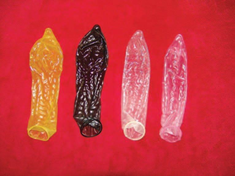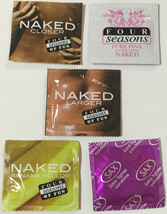Things to try if a condom breaks while you’re bonking:
- Stop the service immediately.
- The penetrative partner needs to pull their penis out immediately. As the professional you’re the expert, so you should keep hold of the base of the condom if it’s still there to make sure the entire condom, or as much as possible, comes out.
- Ask your client to give you some space so that you’re able to move around freely. While they’re getting off you or moving away, take the time to take three deep breaths and clear your mind.
- Check in with your client to see if they are freaking out because you’ll want to calm them down as soon as possible to stop them escalating.
- You and your client should pee to clear and flush away any bodily fluids that may be near your or your client’s urethra. Tell your client to have a shower to wash their genital area. If your client has a penis and is not circumcised, they should pay particular attention to underneath the foreskin.
- When they go into the bathroom, just pause for a moment and take the time to compose yourself.
- Put a towel on the floor, squat over the towel, bear down and squeeze your vaginal muscles or bear down on your anal muscles to try and push out any semen or pieces of condom that may have broken off inside you. Coughing and sneezing is also a good way to push things out of your vagina and butt.
- As gross as this sounds, get the broken condom pieces and put them down flat on the towel and reassemble it to see if any of the condom has broken off and is still inside you. Sometimes condoms don’t just split, they can break up into several pieces, so reassemble it like a jigsaw puzzle to make sure it’s all out.
- When you hear the client turn off the shower, pick up the towel and prepare yourself to have an STI discussion with your client if they need it.
- If your client comes out of the bathroom and wants to continue having sex, let them know that’s not an option. If there is any semen or condom left inside you, it may push it further up into your vagina or anus. Friction from having sex can also cause micro-tears in your vagina or butt, so you don’t want to risk that happening with cum inside you. As soon as you can, get to a toilet and keep bearing down and squeezing your muscles to try and expel any cum.
- If you have a broken condom in your vagina, urinating is also a good idea at this stage.
- If there is any broken condom inside you, or the condom has slipped off and you cannot squeeze it out, try and get to a doctor or sexual health service ASAP. Using your fingers to get a condom out should be your very last choice and you need to be REALLY careful not to scratch yourself if you decide to dig around inside your butt or vagina. If you do decide to use your fingers, try to put on a few sets of gloves so that your fingers aren’t as scratchy, especially if you have long fingernails.
What NOT to do if a condom breaks or slips off inside your vagina or butt
Don’t try and scoop the cum out of your vagina or butt with your fingers because you may scratch yourself inside, which will increase the chances of an infection occurring.
Don’t douche because the water you push into your vagina or butt to try and flush the cum out will just push it further up. Douching also strips the mucous lining of your vagina or butt and upsets your body’s natural defence system. It can also create micro-tears, which cum can enter and make STI transmission easier.
Don’t have a bath because the water that enters your vagina or butt can push the cum further up.

Emergency contraception
If you’re not using a contraceptive other than the condom, seriously consider taking emergency contraception.
There are three emergency contraception options in Australia:
1. A 1.5mg single dose levonorgestrel emergency contraceptive pill (LNG-ECP), licensed for use up to 72 hours (three days) after unprotected sex.
2. A 30mg single dose ulipristal acetate emergency contraceptive pill (UPA-ECP) licensed for use up to 120 hours (five days) after unprotected sex.
3. Insertion of a copper intra-uterine device (IUD) within 120 hours of unprotected sex, which also provides very effective long-term contraception.
Most sexual health services provide some type of emergency contraception and you for some don’t need a prescription to get it over the counter at the chemist. It can make your period irregular for your next few cycles. Be sure to read the information pamphlet on the inside of the box of whatever emergency contraception you choose, and have a chat to the people at the sexual health service or your chemist to find out when and how to take it, how it works and any side-effects you should look out for. Just remember that the pill does not provide protection against any STIs.
PEP (Post Exposure Prophylaxis)
If you go to a sexual health service, they will be able to talk to you about PEP (Post Exposure Prophylaxis), which is a treatment (medication) that MAY prevent HIV infection. It is available to anyone who thinks they may have been exposed to HIV.
Like emergency contraception, it needs to be taken within 72 hours, and it is recommended you take it as soon as possible. PEP can only be prescribed by a limited number of GPs or major hospital Emergency doctors and we recommend you go to one of the sexual health services listed in the referral section at the end of this fact sheet if you are interested in taking it or want to discuss it further.
For more information go to our PEP or Post Exposure Prophylaxis Information Sheet.
Dealing with your client
It’s really a situation in which to remain calm and in control at all times, so don’t panic. It’s also one of the rare times where it’s alright to turn to a client and say “Actually this is very scary for me too, so please have a shower while I look after myself and we can discuss this further when you get out”. Always put yourself first if this ever happens to you, and when you’re in control and comfortable explain to your client that Australian sex workers have the best sexual health of anyone in the community and you have STI screening so the risks to them are very low.
You can also refer your client to a sexual health service for STI screening if he/she is concerned and would like to have a check-up. It’s a good idea to explain the way they work and what he/she can expect if he/ she chooses to go to one so that he/she feels more confident in doing it. Giving someone information makes them feel calmer and more in control.

What can cause a condom to break or slip off?
- opening the packaging of the condom with your teeth or a sharp object and accidentally ripping or tearing it
- not putting the condom on properly
- using oil-based lubricants
- getting oil-based massage oil on the condom, which can happen if you do a massage and body slide and then get the oil on the condom
- bonking hard and fast for a long period of time
- not using enough lube
- using too much lube
- not holding the rim of the condom while the penis is being withdrawn (you can also check it while you’re fucking to make sure it’s still there)
- using more than one condom at a time—if you use two condoms at once or use a male condom and a femidom, the friction of the latex rubbing up will cause the condom to burst
- using expired condoms
- storing condoms in a hot or sunny place, which can cause the latex to deteriorate or disintegrate
- not using a condom that fits the penis properly—if you use one that is too small, it may stretch and be more likely to burst, or it may not go all the way to the base of the penis causing it to slip off. If the condom is too large, then there is the potential for it to slip off.
- Client breaks it or pulls it off deliberately
STIs
When you go to your sexual health service for PEP or for your next STI screening, if you tell them you have had a condom break or slip off they might ask you for a whole lot of information about the person you were having sex with. You can say something like “It was anonymous and I simply don’t have any of that information.” Don’t let them put you off asking for a full set of tests.
Sexual health services will be able to test you for gonorrhoea within 2–3 days of the breakage if you have symptoms, but if you are asymptomatic they cannot take tests for two weeks. It is advisable to attend your sexual health service or doctor for repeat screening of STIs two weeks after the incident and then again in 3 and 6 months time. If you’re taking PEP, they will give you different dates and timeframes they’d like to see you for blood tests.
Over the week and up to 4 weeks after you have the breakage or slippage, be aware of any itchiness, scratchiness, lumps, bumps or discharge, as this may indicate an STI or could also indicate that some of the condom is still caught inside you and needs to be removed.
The most important thing to remember with a condom slipping or breaking is that it’s not your fault. Accidents do happen and it’s always possible that the condom could have been damaged sometime during or after production while it was still in factory.
Check with Respect Inc for a doctor that can prescribe PEP and places you can go for sexual health checks.
You may like to try the emergency department of any major hospital, your local QuIHN clinic, or a sexual health clinics.
If you have time call ahead first and make an appointment. Sexual health services and doctors’ surgeries may have limited opening hours and not be open on weekends. If it’s a weekend or late at night and you can’t access or call one of these services, you’ll have to go to emergency
If you do go to Emergency, you may need to request a letter or copies of your information to give to the sexual health clinic or GP of your choice for follow-up appointments. Respect Inc. has a fact sheet dedicated to PEP.
Disclaimer:
All material in this information sheet is provided for your information only and may not be construed as legal, medical or health advice or instruction.





